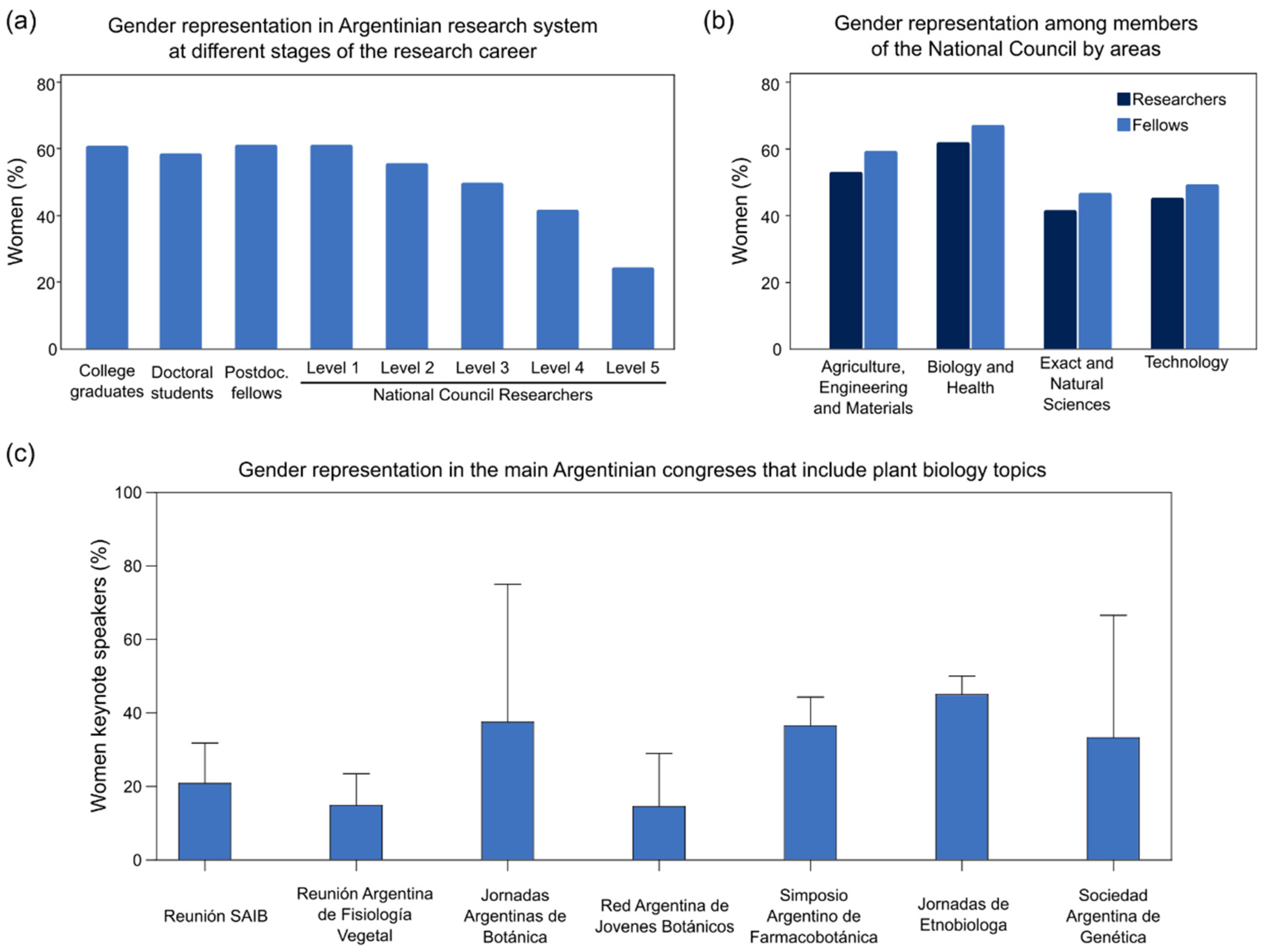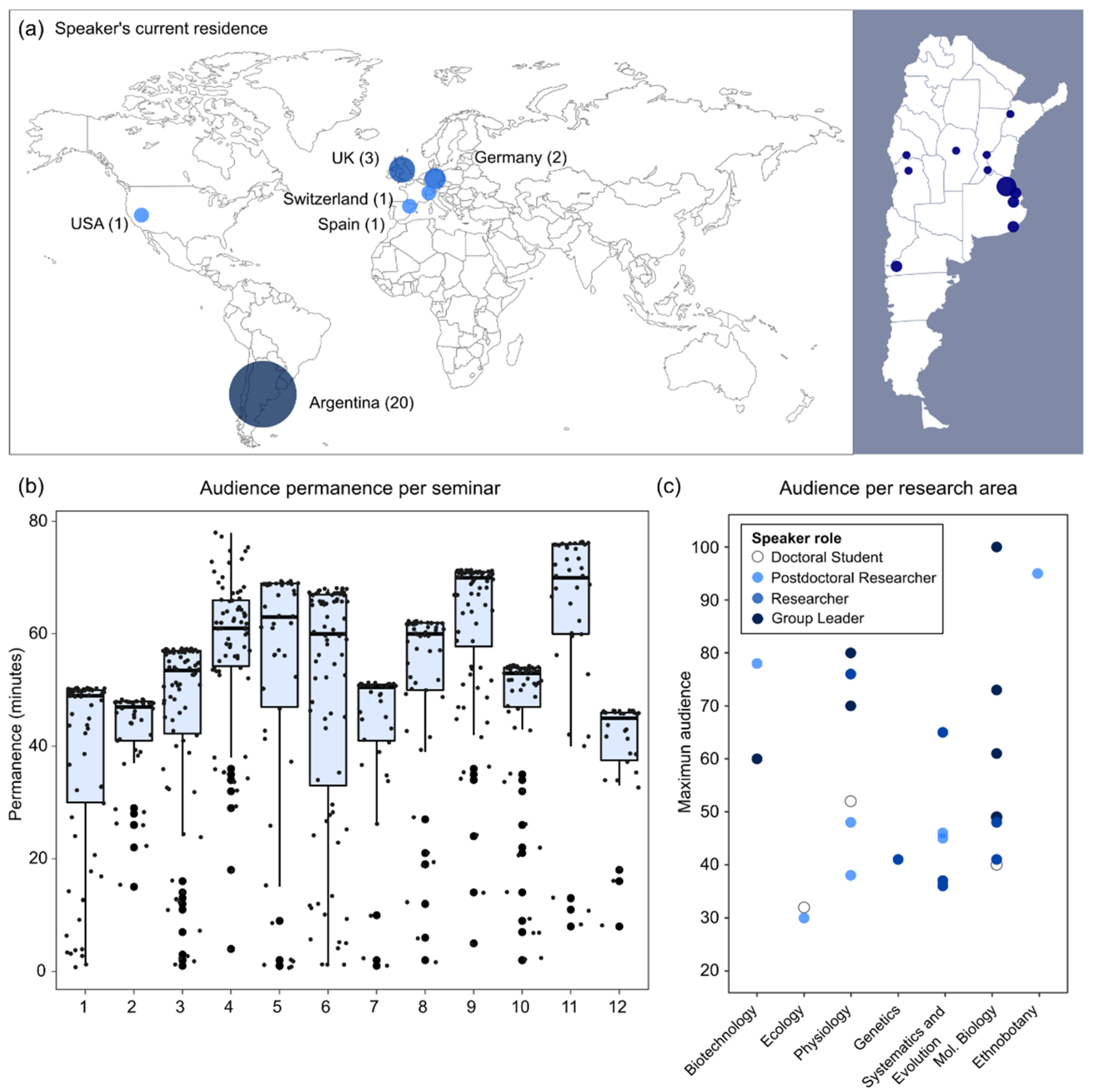Building a Pathway for Diversity in Plant Sciences in Argentina: Highlighting the Work of Women Scientists through Virtual Activities †
Abstract
:1. Introduction
2. Gender Representation in the Plant Sciences in Argentina
3. ARG Plant Women: The Argentinian Network of Women in Plant Sciences
4. Outcomes and Self-Evaluation
5. Next Steps
6. Conclusions
Supplementary Materials
Author Contributions
Institutional Review Board Statement
Informed Consent Statement
Data Availability Statement
Acknowledgments
Conflicts of Interest
Appendix A. List of Seminar Speakers Showing Seminar Date, Affiliation, Role Field, and Seminar Title. Videos Available in Our YouTube Channel
| Date | Speaker | Affiliation | Role | Field | Topic |
| 6 April 2020 | Rocío Deanna | CU Boulder, US/Natural History Museum, UK | Postdoctoral Researcher | Systematics and Evolution | Evolución de la tribu Physalideae (Solanaceae) + Difusión de ciencia |
| 13 April 2020 | Anahí Yáñez | CIGEOBIO, CONICET-UNSJ, AR | Postdoctoral Researcher | Genetics | Retroelementos como marcadores moleculares en ají (Capsicum, Solanaceae) |
| 20 April 2020 | Mariana Corigliano | INTECH, CONICET-UNSAM, AR | Researcher | Biotechnology | HSP90 de plantas como inmunomoduladores de la RI + Divulgación y extensión |
| 27 April 2020 | Gabriela Amodeo | FCEN-UBA & IBBEA UBA-CONICET, AR | Group Leader | Physiology | Acuaporinas en plantas: los nuevos desafíos |
| 5 May 2020 | Laura Las Peñas | IMBIV, CONICET-UNC, AR | Researcher | Systematics and Evolution | Diversidad de Cactaceae: aspectos genéticos, morfológicos y ecológicos |
| 11 May 2020 | Gabriela Auge | iB3, FCEN-UBA, AR | Group Leader | Physiology | Vías de floración regulan pleiotrópicamente dormición y germinación de semillas |
| 18 May 2020 | Agostina Sassone | IPK—Leibniz Institute, DE | Postdoctoral Researcher | Systematics and Evolution | Dilucidando la taxonomía de los ajos sudamericanos (tribu Leucocoryneae) |
| 1 June 2020 | Gabriela Pagnussat | IIB, CONICET-UNMDP, AR | Group Leader | Molecular Biology | Síntesis de homocastasterona en el gametofito femenino de A. thaliana |
| 8 June 2020 | Martina Legris | Fankhauser’s lab, UNIL, CH | Postdoctoral Researcher | Physiology | Rol de los fotorreceptores en el control del desarrollo en Arabidopsis |
| 16 June 2020 | Paula Casati | CEFOBI, CONICET-UNR, AR | Group Leader | Molecular Biology | Flavone biosynthesis and salicylic acid hydroxylation in plants |
| 25 June 2020 | Mariana Grossi | División Plantas Vasculares, Museo de La Plata, AR | Postdoctoral Researcher | Systematics and Evolution | Análisis comparativo de caracteres reproductivos en Eupatorieae (Asteraceae) |
| 29 June 2020 | Ana Srur | IANIGLA-CONICET, AR | Researcher | Ecology | Dinámica de los bosques en los Andes patagónicos argentinos: dendroecología |
| 3 August 2020 | Debora Rondanini | FAUBA, UBA, AR | Researcher | Physiology | Avances en ecofisiología de colza-canola |
| 10 August 2020 | Eugenia Zanetti | IBBM-FCE-UNLP, CONICET, AR | Group Leader | Molecular Biology | To keep or not to keep: mRNA stability and translatability in root nodule symbiosis |
| 24 August 2020 | Alicia Lopez Mendez | FCA UNMDP, CONICET, AR | Researcher | Systematics and Evolution | Nuestras líneas de investigación en botánica |
| 31 August 2020 | Julia Qüesta | CRAG, ESP | Group Leader | Molecular Biology | Epigenetic memory in plants |
| 7 September 2020 | Victoria Gastaldi | IAL, AR | PhD Student | Molecular Biology | Las proteínas TCPs y su participación en la elongación del estambre en A. thaliana |
| 14 September 2020 | María Laura Vidoz | IBONE, UNNE, CONICET, AR | Researcher | Physiology | Respuestas adaptativas de las plantas de tomate a la inundación |
| 21 September 2020 | Ana Ladio | INIBIOMA, AR | Researcher | Ethnobotany | Etnobotánica patagónica: vínculos con las plantas y su rol en conservación biocultural |
| 28 September 2020 | Pamela Ribone | SLCU, UK | Postdoctoral Researcher | Molecular Biology | Regulación de la expresión génica mediada por uORFs |
| 5 October 2020 | Luciana Bianchimano | FIL/IBBA-CONICET, AR | PhD Student | Physiology | Respuestas de las plantas al desafío impuesto por altas densidades de cultivo |
| 19 October 2020 | María Florencia Ercoli | Department of Plant Pathology, UC Davis, US | Postdoctoral Researcher | Molecular Biology | RaxX modifies the host environment by mimicking a plant peptide hormone |
| 26 October 2020 | Marina Clemente | INTECH, CONICET-UNSAM, AR | Group Leader | Biotechnology | Las plantas para la producción de proteínas de uso terapéutico + Ciencia en el bar |
| 2 November 2020 | Julieta Cagnacci | IIFA, INTA-CONICET, AR | PhD Student | Ecology | El impacto de diferentes ambientes naturales a lo largo de la altitud en las dinámicas de regeneración de dos especies de Nothofagus en los Andes Patagónicos |
| 9 November 2020 | Daniela Sueldo | SLS, Warwick University, UK | Group Leader | Molecular Biology | Plant immune cell death: execution and multicellular coordination |
| 16 November 2020 | Florencia Yannelli | Ecological Novelty group, FU-Berlin, DE | Researcher | Ecology | Restauración ecológica en el contexto de las plantas invasoras |
| 23 November 2020 | Rocío Tognacca | IFIBYNE, UBA-CONICET, AR | Postdoctoral Researcher | Molecular Biology | Regulación del splicing alternativo durante la germinación inducida por luz |
| 30 November 2020 | Agustina Yañez | MACN-CONICET, AR | Researcher | Systematics and Evolution | Biodiversidad de Helechos y Licofitas en áreas protegidas de la provincia de Misiones: 10 años de trabajo en la selva Paranaense |
References
- Nielsen, M.W.; Alegria, S.; Börjeson, L.; Etzkowitz, H.; Falk-Krzesinski, H.J.; Joshi, A.; Leahey, E.; Smith-Doerr, L.; Woolley, A.W.; Schiebinger, L. Opinion: Gender diversity leads to better science. Proc. Natl. Acad. Sci. USA 2017, 114, 1740–1742. [Google Scholar] [CrossRef] [PubMed] [Green Version]
- Woolley, A.W.; Chabris, C.F.; Pentland, A.; Hashmi, N.; Malone, T.W. Evidence for a Collective Intelligence Factor in the Performance of Human Groups. Science 2010, 330, 686–688. [Google Scholar] [CrossRef] [PubMed] [Green Version]
- Woolley, A.W.; Aggarwal, I.; Malone, T.W. Collective Intelligence and Group Performance. Curr. Dir. Psychol. Sci. 2015, 24, 420–424. [Google Scholar] [CrossRef]
- Elsevier 3 Reasons Gender Diversity is Crucial to Science. Available online: https://www.elsevier.com/connect/3-reasons-gender-diversity-is-crucial-to-science (accessed on 10 November 2020).
- UNESCO Report: Women in Science; 2019; p. FS/2019/SCI/55. Available online: http://uis.unesco.org/sites/default/files/documents/fs55-women-in-science-2019-en.pdf (accessed on 12 November 2020).
- Potvin, D.A.; Burdfield-Steel, E.; Potvin, J.M.; Heap, S.M. Diversity begets diversity: A global perspective on gender equality in scientific society leadership. PLoS ONE 2018, 13, e0197280. [Google Scholar] [CrossRef] [Green Version]
- Mauleón, E.; Hillán, L.; Moreno, L.; Gómez, I.; Bordons, M. Assessing gender balance among journal authors and editorial board members. Scientometrics 2013, 95, 87–114. [Google Scholar] [CrossRef] [Green Version]
- Adams, R.B.; Kirchmaier, T. Women on Boards in Finance and STEM Industries. Am. Econ. Rev. 2016, 106, 277–281. [Google Scholar] [CrossRef] [Green Version]
- Wang, M.-T.; Degol, J.L. Gender Gap in Science, Technology, Engineering, and Mathematics (STEM): Current Knowledge, Implications for Practice, Policy, and Future Directions. Educ. Psychol. Rev. 2017, 29, 119–140. [Google Scholar] [CrossRef] [PubMed]
- Martin, J.L. Ten Simple Rules to Achieve Conference Speaker Gender Balance. PLoS Comput. Biol. 2014, 10, e1003903. [Google Scholar] [CrossRef] [PubMed] [Green Version]
- Kong, S.; Carroll, K.; Lundberg, D.; Omura, P.; Lepe, B. Reducing gender bias in STEM. MIT Sci. Policy Rev. 2020, 1, 55–63. [Google Scholar] [CrossRef]
- Athena Swan Charter|Advance HE. Available online: https://www.advance-he.ac.uk/equality-charters/athena-swan-charter (accessed on 11 November 2020).
- Best, K.L.; Sanwald, U.; Ihsen, S.; Ittel, A. Gender and STEM in Germany: Policies Enhancing Women’s Participation in Academia. Int. J. Gend. Sci. Technol. 2013, 5, 292–304. [Google Scholar]
- Biaswatchneuro. Available online: https://biaswatchneuro.com/ (accessed on 11 November 2020).
- Moss-Racusin, C.A.; van der Toorn, J.; Dovidio, J.F.; Brescoll, V.L.; Graham, M.J.; Handelsman, J. A “Scientific Diversity” Intervention to sReduce Gender Bias in a Sample of Life Scientists. LSE 2016, 15, ar29. [Google Scholar] [CrossRef] [PubMed] [Green Version]
- Brewer, P.R.; Ley, B.L. “Where My Ladies At?”: Online Videos, Gender, and Science Attitudes among University Students. Int. J. Gend. Sci. Technol. 2018, 9, 278–297. [Google Scholar]
- Weyer, B. Twenty years later: Explaining the persistence of the glass ceiling for women leaders. Women Manag. Rev. 2007, 22, 482–496. [Google Scholar] [CrossRef]
- Portal de Sicytar. Available online: http://sicytar.mincyt.gob.ar/ (accessed on 11 November 2020).
- Spu Sceu. Available online: http://estadisticasuniversitarias.me.gov.ar/#/home (accessed on 12 November 2020).
- Arg Plant Women. Available online: https://argplantwomen.weebly.com/ (accessed on 12 November 2020).
- Biólogas Plantas Argentina—YouTube. Available online: https://www.youtube.com/channel/UCK6Kt29dfHLOblmUxc0YhOQ (accessed on 12 November 2020).



| Social Platform | Subscribers/Followers | Impressions | Likes | Other Metrics |
|---|---|---|---|---|
| 666 | 31.5 K/month | ~340/month | ||
| YouTube [21] | 94 | 34.3 K total | ~120 total | ~1800 total views |
| 508 | ~280/post |
Publisher’s Note: MDPI stays neutral with regard to jurisdictional claims in published maps and institutional affiliations. |
© 2020 by the authors. Licensee MDPI, Basel, Switzerland. This article is an open access article distributed under the terms and conditions of the Creative Commons Attribution (CC BY) license (https://creativecommons.org/licenses/by/4.0/).
Share and Cite
Auge, G.A.; de Leone, M.J.; Deanna, R.; Oliferuk, S.; Ribone, P.A.; Welchen, E. Building a Pathway for Diversity in Plant Sciences in Argentina: Highlighting the Work of Women Scientists through Virtual Activities. Biol. Life Sci. Forum 2021, 4, 36. https://doi.org/10.3390/IECPS2020-08569
Auge GA, de Leone MJ, Deanna R, Oliferuk S, Ribone PA, Welchen E. Building a Pathway for Diversity in Plant Sciences in Argentina: Highlighting the Work of Women Scientists through Virtual Activities. Biology and Life Sciences Forum. 2021; 4(1):36. https://doi.org/10.3390/IECPS2020-08569
Chicago/Turabian StyleAuge, Gabriela Alejandra, María José de Leone, Rocío Deanna, Sonia Oliferuk, Pamela Anahí Ribone, and Elina Welchen. 2021. "Building a Pathway for Diversity in Plant Sciences in Argentina: Highlighting the Work of Women Scientists through Virtual Activities" Biology and Life Sciences Forum 4, no. 1: 36. https://doi.org/10.3390/IECPS2020-08569
APA StyleAuge, G. A., de Leone, M. J., Deanna, R., Oliferuk, S., Ribone, P. A., & Welchen, E. (2021). Building a Pathway for Diversity in Plant Sciences in Argentina: Highlighting the Work of Women Scientists through Virtual Activities. Biology and Life Sciences Forum, 4(1), 36. https://doi.org/10.3390/IECPS2020-08569






